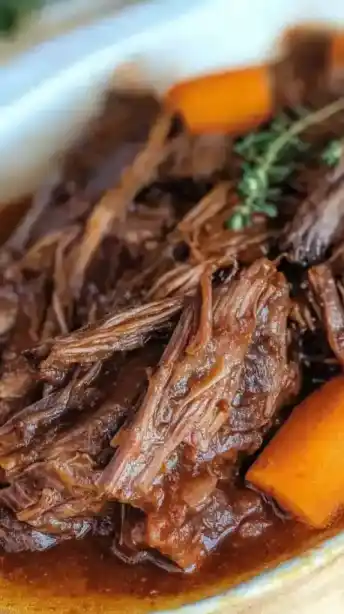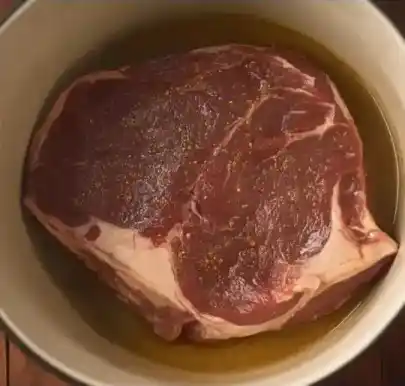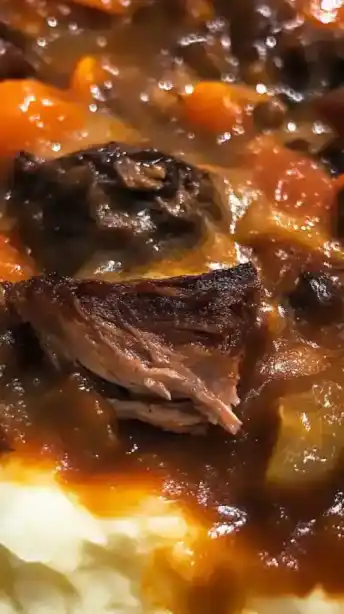The Best Fluffy Pancakes recipe you will fall in love with. Full of tips and tricks to help you make the best pancakes.

There’s something magical about a perfectly cooked chuck roast. It’s the kind of meal that fills your home with an irresistible aroma, makes everyone eager for dinner, and delivers fall-apart, melt-in-your-mouth tenderness with every bite. This recipe takes the classic chuck roast and elevates it with deep flavors, a rich, savory broth, and hearty vegetables that soak up all that goodness.
If you’ve been searching for the best chuck roast recipe, you just found it. Trust me, this one’s a game-changer! Let’s get started.
Table of Contents
Why This is the Best Chuck Roast Recipe on the Internet
✔️ One-Pot Wonder – Less cleanup, more flavor.
✔️ Perfectly Tender – Braised low and slow to perfection.
✔️ Customizable Flavors – Easily tweak with different seasonings and liquids.
✔️ Beginner-Friendly – Follow this step-by-step guide, and you can’t mess it up.
✔️ Leftovers Transform into New Meals – (Hello, Quick Beef Tacos!)

Ingredients for the Ultimate Chuck Roast
For the Roast:
- 4 lb boneless beef chuck roast (or brisket for a different twist)
- 2 tbsp unsalted butter (or ghee for a deeper flavor)
- 1 tbsp vegetable oil (canola or avocado oil works best)
- Salt & black pepper (to taste, but don’t be shy!)

For the Aromatics & Vegetables:
- 1 large yellow onion, cut into wedges
- 4 cloves garlic, smashed (because more garlic = more flavor!)
- 6 whole carrots, peeled and cut into large chunks
- 2 celery stalks, chopped into large pieces
- 4 Yukon Gold potatoes, quartered (Russet works too, but they break down more)
For the Braising Liquid:
- 2 sprigs fresh rosemary (or 1 tsp dried)
- 2 bay leaves
- 6 oz tomato paste (adds richness and depth)
- 1 cup red wine (Merlot or Cabernet for best flavor – trust me on this)
- 2 cups beef broth (use homemade for an extra rich taste)
Step-by-Step: How to Cook Chuck Roast to Perfection
1️⃣ Sear the Beef for Maximum Flavor
- Preheat your oven to 325°F (163°C).
- Generously season your chuck roast with salt and black pepper on all sides.
- In a large Dutch oven, heat butter and oil over medium-high heat.
- Sear the roast for about 4-5 minutes per side, until a deep golden crust forms. (This step locks in those incredible flavors!)
- Remove the roast and set aside.

2️⃣ Build the Flavor Base
- In the same pot, toss in the onions, garlic, carrots, and celery.
- Sauté for 5 minutes, stirring occasionally, until fragrant and slightly caramelized.
- Stir in tomato paste, mixing well, and cook for 2-3 more minutes.

3️⃣ Deglaze the Pot Like a Pro
- Pour in the red wine and use a wooden spoon to scrape up those delicious brown bits at the bottom. (That’s where all the magic is!)
- Let it simmer for 3 minutes to cook off the alcohol and intensify the flavor.
4️⃣ The Slow Braise Begins
- Nestle the chuck roast back into the pot.
- Add potatoes, rosemary, bay leaves, and beef broth.
- Cover and transfer to the oven.
5️⃣ Low & Slow = Fall-Apart Tender
- Cook for 3.5 to 4 hours, checking at the 3-hour mark with a fork.
- When done, the beef should easily shred apart with a fork. If it’s not there yet, give it another 30 minutes.

6️⃣ Rest & Serve
- Remove the bay leaves and rosemary sprigs.
- Let the roast rest for 10-15 minutes before shredding.
- Serve with extra gravy, and get ready to enjoy pure comfort on a plate.
Pro Tips for the Best Chuck Roast
✅ Don’t skip the sear! It’s the key to deep, rich flavor.
✅ Use whole carrots & potatoes. They hold up better than baby carrots or chopped potatoes.
✅ Go for a good red wine. A drinkable one makes all the difference in flavor.
✅ Check for doneness at 3 hours. If your fork doesn’t slide in like butter, let it go longer.
What to Serve with Chuck Roast
This dish is already packed with flavor, but here are some delicious pairings:
🥔 Mashed Potatoes – The perfect creamy base for soaking up all that beefy gravy.
🥖 Crusty Bread – Because you’ll want something to mop up every last drop of sauce!
🥦 Garlic Butter Green Beans – A fresh, bright side to balance the richness.
Leftover Chuck Roast? Here’s What to Do!
You’re in luck—leftover chuck roast might be even better the next day! Try these ideas:
🌮 Beef Tacos – Shred the meat and load up some tortillas with fresh toppings.
🍜 Beef Noodle Soup – Add broth, veggies, and noodles for a cozy meal.
🥪 Shredded Beef Sandwiches – Pile the roast onto toasted bread with melted cheese.
Best Wine Pairings for Chuck Roast
Pairing the right wine can elevate your chuck roast experience. Here are some top picks:
- Cabernet Sauvignon – Deep, bold, and tannic, complements the richness of the beef.
- Malbec – Velvety with dark fruit notes, a fantastic match for a slow-cooked roast.
- Syrah/Shiraz – Smoky and peppery, enhances the meaty depth of chuck roast.
🔗 Related: Mastering Easy Dinner Recipes
Global Variations of Chuck Roast
Chuck roast is a universal comfort food, but different cultures have their own spin:
- French Pot-au-Feu – Slow-braised beef with root vegetables and herbs.
- Mexican Birria – Shredded chuck roast simmered in a chili-infused broth.
- Italian Stracotto – Chuck roast slow-cooked with tomatoes and red wine.
Alternative Cooking Methods
🐢 Slow Cooker Chuck Roast
- Set it and forget it! Cook on low for 8-10 hours or high for 4-6 hours.

⚡ Instant Pot Chuck Roast
- Cuts cooking time in half! Pressure cook for 60-70 minutes with natural release.
🔗 Related: Beef Stir-Fry Recipe
Creative Ways to Use Leftover Chuck Roast
✔️ Quick Beef Tacos – Perfect for shredded beef tacos with guacamole.
✔️ Beef Noodle Soup – Add broth, veggies, and noodles for a cozy meal.
✔️ Shredded Beef Sandwiches – Load it up with cheese and caramelized onions.
✔️ Beef-Stuffed Peppers – Mix shredded roast with rice and bake in bell peppers.
How to Choose the Best Chuck Roast
When shopping for chuck roast, look for:
✅ Marbling – More fat = more flavor and tenderness.
✅ Bright Red Color – Fresh, high-quality beef should be bright red, not brownish.
✅ Firm to the Touch – A good chuck roast should feel dense and well-marbled.
The Best Meat Cuts for Braising Besides Chuck Roast
While chuck roast is the king of braised beef, there are other cuts that work beautifully for slow-cooked dishes. If your local store is out of chuck roast, here are some great alternatives:
1️⃣ Beef Brisket
- Texture: Slightly leaner than chuck but still incredibly flavorful.
- Best For: Slow cooking, BBQ, or oven braising.
- Tip: Slice against the grain to keep it tender.
2️⃣ Short Ribs
- Texture: Rich, fatty, and ultra-tender when braised.
- Best For: Deep, robust flavors (pairs beautifully with red wine).
- Tip: Cook for at least 3-4 hours for fall-apart texture.
3️⃣ Beef Shank (Osso Buco)
- Texture: Contains a marrow-rich bone that creates velvety sauces.
- Best For: Italian-style braises and soups.
- Tip: Simmer slowly for maximum richness.
4️⃣ Bottom Round Roast
- Texture: Leaner than chuck but holds up well to slow braising.
- Best For: Slicing rather than shredding.
- Tip: Marinate beforehand to enhance tenderness.
5️⃣ Oxtail
- Texture: Gelatin-rich for deep, meaty flavor.
- Best For: Caribbean-style stews and thick gravies.
- Tip: Skim off excess fat after cooking for a cleaner sauce.
🔗 Related: Perfect Beef Cheeks – Another super tender option for slow cooking.
Common Mistakes to Avoid When Cooking Chuck-Roast
Even the best chuck roast recipe can go wrong if you make these common mistakes. Avoid them, and you’ll get perfectly juicy, tender beef every time!
🚫 Mistake #1: Skipping the Sear
❌ Why it’s bad: You’re missing out on the deep, caramelized crust that adds richness.
✅ Fix it: Always sear your roast until golden brown before braising!
🚫 Mistake #2: Cooking at Too High a Temperature
❌ Why it’s bad: Cooking at above 350°F will dry out your roast.
✅ Fix it: Stick to 325°F or lower for fall-apart tenderness.
🚫 Mistake #3: Using Too Much Liquid
❌ Why it’s bad: The roast shouldn’t be submerged—too much liquid can make it soggy.
✅ Fix it: Add just enough liquid to cover the bottom half of the roast.
🚫 Mistake #4: Not Checking for Doneness
❌ Why it’s bad: Undercooked beef is tough, overcooked beef falls apart too much.
✅ Fix it: Use a meat thermometer—aim for 195°F-205°F for shreddable texture.
🚫 Mistake #5: Skipping the Rest Time
❌ Why it’s bad: Cutting into the roast too soon will cause juices to escape.
✅ Fix it: Let the roast rest at least 10-15 minutes before serving.
🔗 Related: Mastering Easy Dinner Recipes – More expert tips for foolproof meals.
By avoiding these common mistakes and choosing the right cut of beef, you’ll guarantee a chuck roast that’s worthy of a five-star review! 🔥🍽️
Now, get cooking and enjoy the most flavorful, fall-apart chuck roast ever! 😍
FAQs About Cooking Chuck-Roast
What’s the best cut of beef for slow cooking?
Chuck roast is the king of slow cooking! Other great choices include brisket and bottom round roast.
Can I make this in a slow cooker?
Absolutely! Just sear the beef first, then cook on low for 8-10 hours or high for 4-6 hours.
Do I have to use red wine?
No, but it adds an incredible depth of flavor. If you’d rather skip it, substitute with more beef broth.
How do I store leftovers?
Keep leftovers in an airtight container in the fridge for up to 4 days. For longer storage, freeze for up to 3 months.
How do I make a thicker gravy?
Remove the beef, then mix 1 tbsp cornstarch with 2 tbsp cold water and stir it into the liquid. Simmer until thickened.
Final Thoughts: Your New Go-To Chuck Roast Recipe
If you’ve been looking for the ultimate chuck roast recipe, this is it. Tender, juicy, packed with flavor, and perfect for any night of the week. Whether you serve it with mashed potatoes or turn the leftovers into tacos, this dish will always hit the spot.
Now, go grab that chuck roast and get cooking! You’re about to make something seriously delicious. 😍
🔗 Related Recipes:
- Beef Stir-Fry Recipe – Perfect for repurposing leftovers.
- Mastering Easy Dinner Recipes – More meal ideas!
Love this recipe? Share it & leave a comment below! Happy cooking! 🍽️🔥










[…] tips on prepping beef, check out this chuck roast guide, which covers how to handle tougher cuts for slow […]